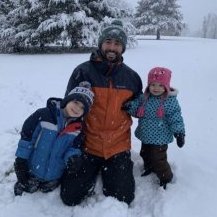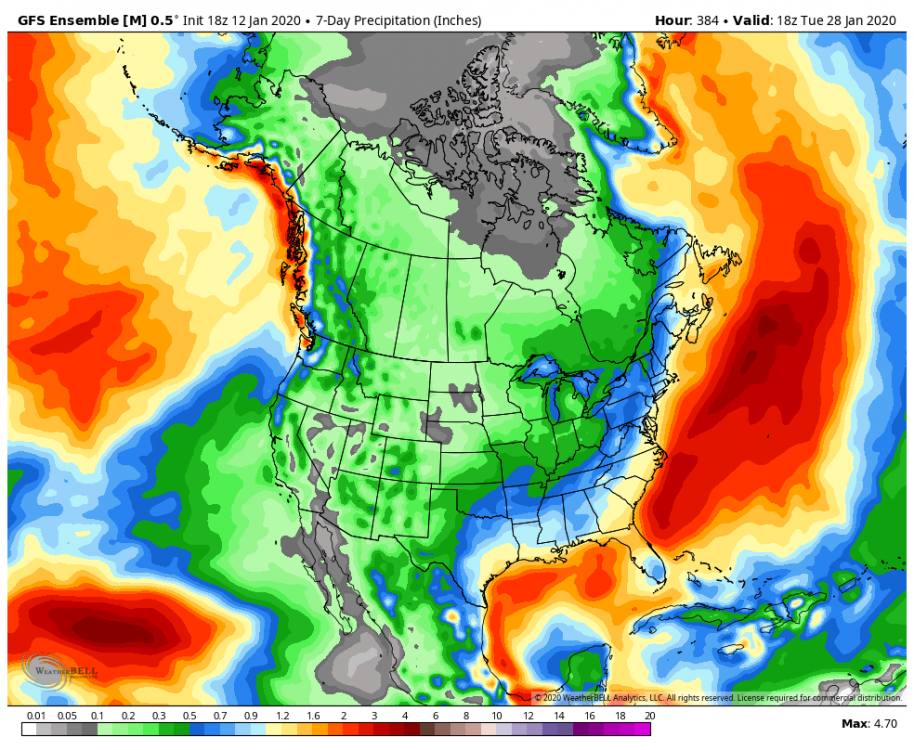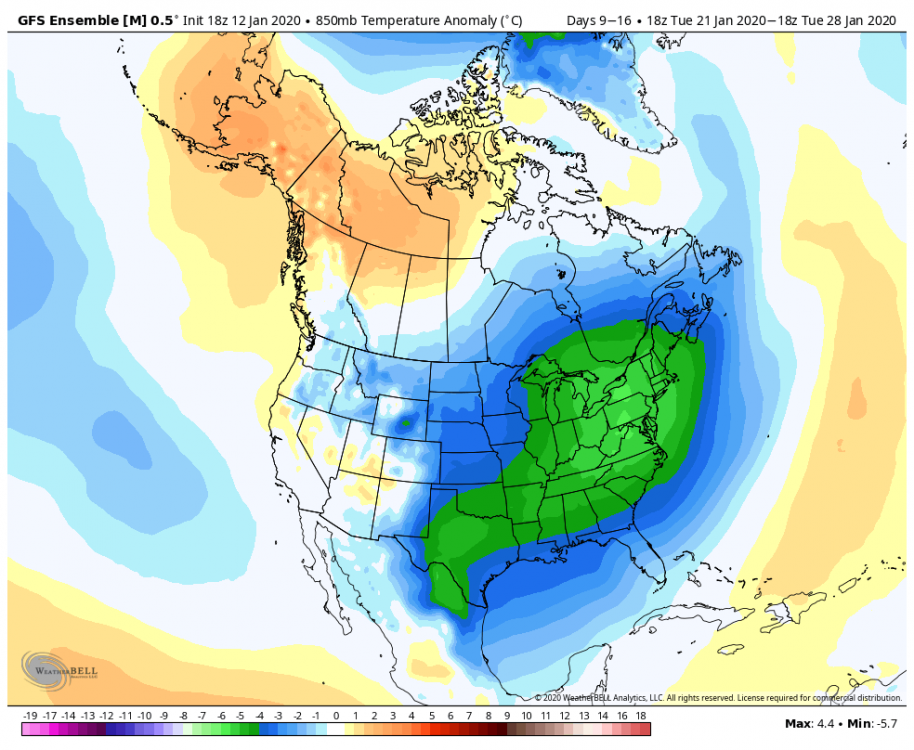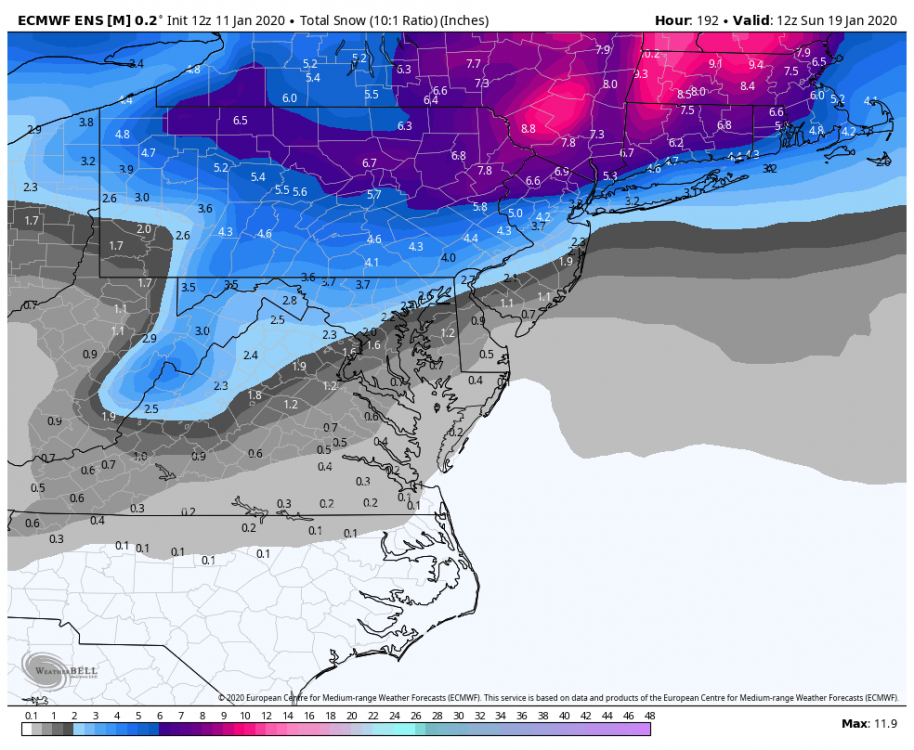-
Posts
26,561 -
Joined
-
Last visited
Content Type
Profiles
Blogs
Forums
American Weather
Media Demo
Store
Gallery
Everything posted by psuhoffman
-
op GFS gonna be too warm it looks like for the day 10/11 gulf low threat. Breaks part of the block over Canada off and dives it into the northeast which allows a bit too much ridging in front and causes the trough to dig in slightly too far to our west. But its damn close to a big storm for that range. Just need a slight adjustment.
-
It would be nice to put down a snowpack at the start of the pattern change because whatever happens it is likely to stay cold a while after with a 1040 high dropping into the midwest behind the system and the epo ridge going ape in the longer range. We could have a rare situation with extended snowcover "IF" this threat works out. Especially if we can get some appreciable ice on top of a few inches of snow.
-
GFS has a dryslot, probably due to down-sloping, across VA but I would have to look at the exact wind flow to see. But that kind of dryslot, while possible, is dependent on the exact wind trajectory to be correct. The lighter precip rates also negatively impact the thermal profile as less mixing out of the warm layer. The result is ugly there...but that is not the kind of meso scale feature the GFS is going to get right at this range so don't worry, the larger more important factors all broke our way this run.
-
That is a snow sounding with any decent rates. Although the best lift is below the DGZ and in the warm layer...so it likely would be an icy rimed messy low ratio 5-1 type snow....but still.
-
Wait the icon doesn’t start as rain all the way to Burlington VT anymore?
-
@showmethesnow great write up. How many times has a ns vort pinwheeling around a 50/50 screwed us by squashing a threat...or a blocking ridge trended weaker allowing a cutter. Nice if both those features could work to our advantage for once.
-
Despite some pretty good blocking across Canada the AO looks to remain positive, although much less so. And while everyone is focused on the epo which is the best way to get consistent cold despite a +AO, the look of ridging near Hudson Bay with an active STJ cutting under it on the EPS has my attention. That feature is one of the best ways to get a big snow during a +AO regime.
-
Agree with this. I’m not totally sure what happens up top though. It’s a sudden flip to blocking then a sudden flip back although with a perfect epo ridge. But that’s two sudden high latitude reversals in a week. Volatile to say the least.
-
-
Got trough?
-
I’m not dismissing it. But I’m not throwing a mini melt over every op run shift either. And if it fails I’m not acting like it’s our last chance at snow. That’s all.
-
Yea it’s close enough not to toss the window. Either way did you see the day 12-15 window? I mean either way the overall setup is good but with that look up top it is possible for something to get suppressed. But usually when we get blocking not every storm gets squashed. Especially as its shifts to epo blocking vs the ridge bridge look day 10.
-
If anything the gefs is trending too strong with the blocking next week. Most runs suppress the system after the weekend one into the southeast. Too much ridging in Canada forces the trough axis southeast of us. Still likely to set up a threat as it relaxes later in the week.
-
Some people need to relax. Go to TT and cycle the last 10 runs. It’s just bouncing around between decent and not so good runs. No trend. Eventually it will get a handle on the details but not likely at this range. And even if we get a real trend (which would be over several runs with ens support not one op) it could trend back. Or maybe it won’t and who cares this isn’t our last chance. It’s mid Jan not March. Why are some living in every run for a marginal front end thump on a cutter in mid Jan when much better threats are likely ahead. I’m not tossing this, just saying calm down a little.
-
So you hung on through 4 weeks of 2 god awful no hope shutout patterns....and now a week away from a change to at least a workable if not legit good pattern you want to jump? Ok
-
Wrt the snow maps, the more sophisticated ones on Wxbell and some other outlets are getting better. The TT ones are still pretty bad wrt ice. The kuchera especially does a better job not over accumulating sleet compared to years past. Snow maps will never be as good as plain old analysis combined with common sense climo adjustment to the NWP but at least they aren’t spitting out crazy stupid maps that make it onto twitter. Now their only semi crazy stupid. Progress! As for the pattern...I agree odds increase with each wave after this week. But there are some pretty crazy blocks combined with strong highs showing up. They shift around every run but time those up right and any one of the waves starting next weekend could deliver a flush hit. But I do agree each wave after Sat has an increasing probability. The long range looks like chaos incarnate but in a good way. Super charger blocks and highs shifting all over North America. Lest we forget it takes anomalous stuff to get a good snow here usually so I’ll my chances with the crazy.
-
Ever since the model page upgrade on wxbell the gefs snow algorithm doesn’t seem to show non snow as 10-1 snow as much as before. They are still not the best tool to use but they don’t seem to be super crazy exaggerated compared to the eps due to 20” of snow from a low 500 miles NW of us like before.
-
Next weekend has always been marginal and completely dependent on how details wrt CAD and initial WAA moisture feed set up. But it’s not a great longwave pattern. It would have to break right. After that everything looks the same as outlined yesterday. Next week has a couple threats consistent across guidance. This is a classic look... the look at the end is rare but one that often produces. It wasn’t responsible for a huge number of the snow events I looked at but it was a healthy number considering how rare that type of epo ridge aligned over the top combined with a broad SW to NE conus trough like that is. If we’re going to roll without NAO help after the blocking period day 8-12 that’s the best look to do it. Other than an NAO block that’s the next best look I could draw up. Geps ans gefs both generally support the same ideas for the next 2 weeks and as @Bob Chill has said every piece of guidance we have continues this look into and through February. But seeing the ensembles show clear signs the STJ is likely to continue to be a player and undercut the pna ridge week two and beyond is a great development. The fear with the cfs look is cold dry with only cutters able to turn the corner. The look being shown on the ensembles around 2 weeks which would be more likely to see details than the seasonal guidance relaxes those fears imo.
-
Remember all those times we talked about where we need an epo right to be centered to get snow. Like this... signs of an active stj cutting under doesn’t hurt either.
-
Gefs slightly worse for next weekend but not a significant change. After that is says suppression is the bigger issue for the day 10/11 threat. Shifted the trough axis slightly too far southeast. But for day 10 it’s noise. Big signal for the threat as the blocking relaxes day 12-14. Goes bonkers with the HL ridge around day 10
-
There are 3 discreet windows showing on the gefs and eps. The epo block and ridge across Canada is forcing the system next weekend further south than you would typically expect where it starts out. After that a threat early the following week. Look at the ridge axis out west as the next system dives in. Good ridge bridge over the top. Classic look. Last threat is around day 15. Southern branch feature that cuts under the western ridge and across as the blocking relaxes. Classic.
-
-
Eps is another weenie run. Better for next weekend. Significantly. Good looks after also. Supports the idea of HL blocking day 8-13
-
That one will have a hard time accumulating on roads in the district during the day! We will need some heavy rates to overcome solar, which by then the sun will be like 3” from our face according to Avant Regent.
-
Euro goes berserk with HL blocking day 7-10 also.










